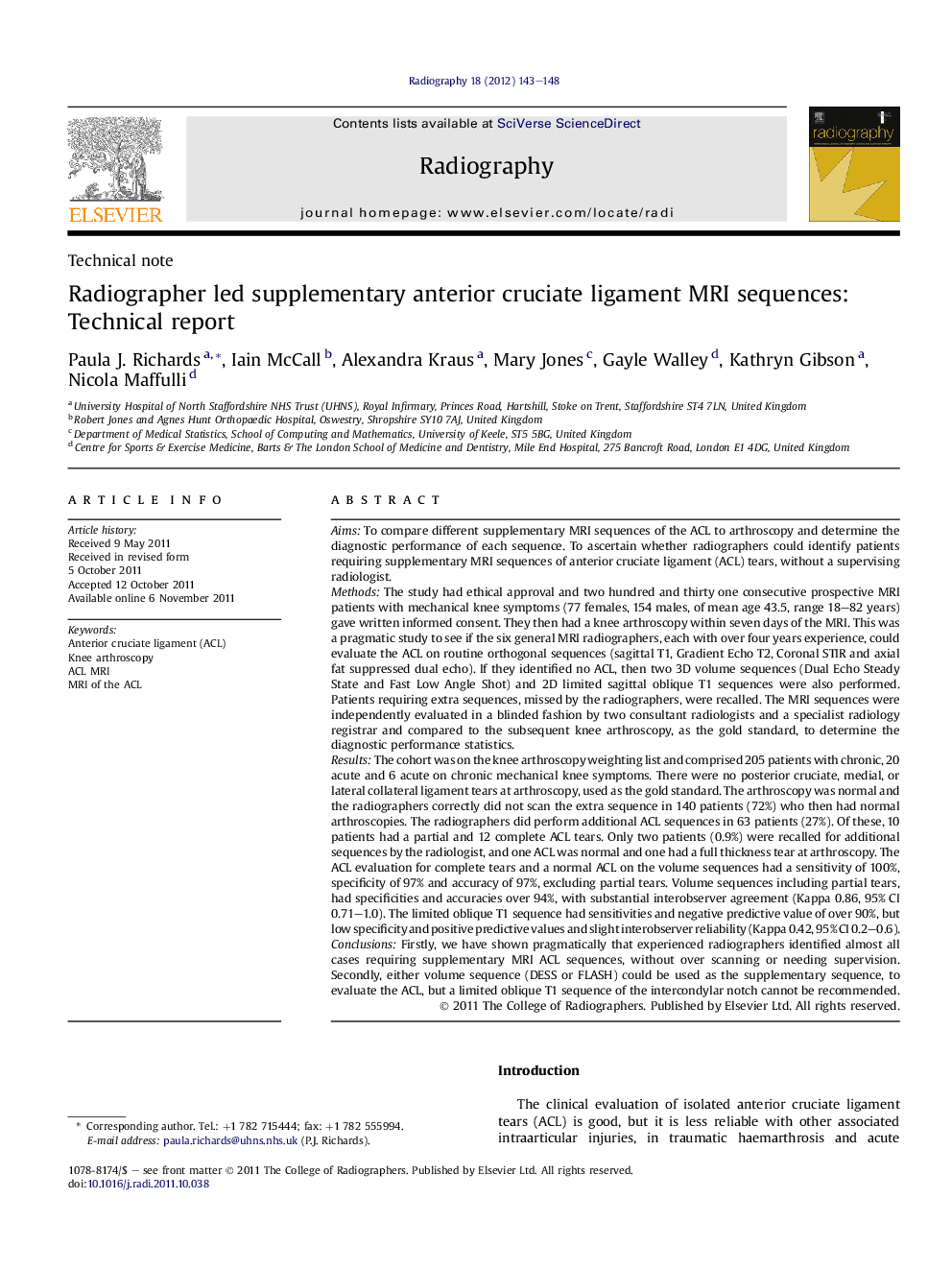| کد مقاله | کد نشریه | سال انتشار | مقاله انگلیسی | نسخه تمام متن |
|---|---|---|---|---|
| 2737431 | 1148061 | 2012 | 6 صفحه PDF | دانلود رایگان |

AimsTo compare different supplementary MRI sequences of the ACL to arthroscopy and determine the diagnostic performance of each sequence. To ascertain whether radiographers could identify patients requiring supplementary MRI sequences of anterior cruciate ligament (ACL) tears, without a supervising radiologist.MethodsThe study had ethical approval and two hundred and thirty one consecutive prospective MRI patients with mechanical knee symptoms (77 females, 154 males, of mean age 43.5, range 18–82 years) gave written informed consent. They then had a knee arthroscopy within seven days of the MRI. This was a pragmatic study to see if the six general MRI radiographers, each with over four years experience, could evaluate the ACL on routine orthogonal sequences (sagittal T1, Gradient Echo T2, Coronal STIR and axial fat suppressed dual echo). If they identified no ACL, then two 3D volume sequences (Dual Echo Steady State and Fast Low Angle Shot) and 2D limited sagittal oblique T1 sequences were also performed. Patients requiring extra sequences, missed by the radiographers, were recalled. The MRI sequences were independently evaluated in a blinded fashion by two consultant radiologists and a specialist radiology registrar and compared to the subsequent knee arthroscopy, as the gold standard, to determine the diagnostic performance statistics.ResultsThe cohort was on the knee arthroscopy weighting list and comprised 205 patients with chronic, 20 acute and 6 acute on chronic mechanical knee symptoms. There were no posterior cruciate, medial, or lateral collateral ligament tears at arthroscopy, used as the gold standard. The arthroscopy was normal and the radiographers correctly did not scan the extra sequence in 140 patients (72%) who then had normal arthroscopies. The radiographers did perform additional ACL sequences in 63 patients (27%). Of these, 10 patients had a partial and 12 complete ACL tears. Only two patients (0.9%) were recalled for additional sequences by the radiologist, and one ACL was normal and one had a full thickness tear at arthroscopy. The ACL evaluation for complete tears and a normal ACL on the volume sequences had a sensitivity of 100%, specificity of 97% and accuracy of 97%, excluding partial tears. Volume sequences including partial tears, had specificities and accuracies over 94%, with substantial interobserver agreement (Kappa 0.86, 95% CI 0.71–1.0). The limited oblique T1 sequence had sensitivities and negative predictive value of over 90%, but low specificity and positive predictive values and slight interobserver reliability (Kappa 0.42, 95% CI 0.2–0.6).ConclusionsFirstly, we have shown pragmatically that experienced radiographers identified almost all cases requiring supplementary MRI ACL sequences, without over scanning or needing supervision. Secondly, either volume sequence (DESS or FLASH) could be used as the supplementary sequence, to evaluate the ACL, but a limited oblique T1 sequence of the intercondylar notch cannot be recommended.
Journal: Radiography - Volume 18, Issue 2, May 2012, Pages 143–148